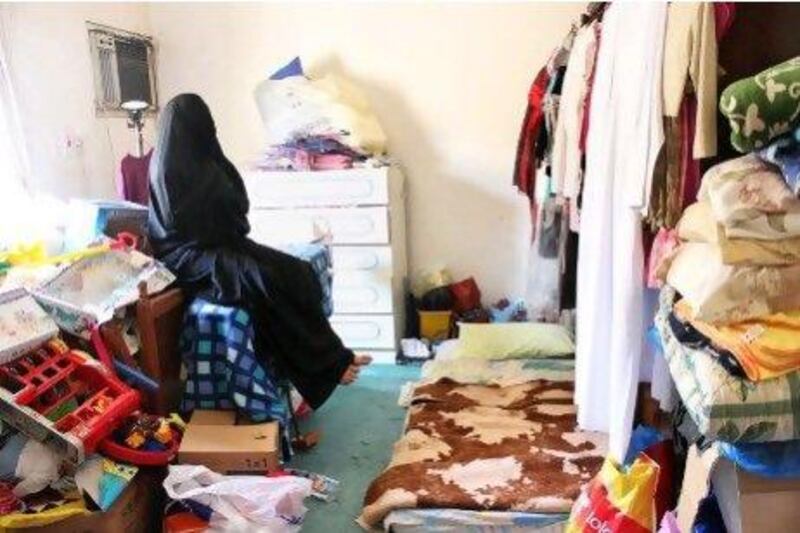RIYADH // When the founders of Alaan Artspace, Riyadh's first contemporary art gallery, were planning their inaugural show, it dawned on them that nearly everyone involved was a woman. It was symbolic, they realised, for more than just their gallery.
"Look at the majority of women in Saudi Arabia - there are more university graduates, for example," said the exhibition curator, Sara Raza. "There are more women artists. The males are more dominant internationally but women are the leading inspiration for young artists."
Soft Power, the Alaan gallery's first exhibition, opened on October 3 and runs until December 10. The works - by the young artists Sarah Abu Abdallah, Sarah Mohanna Al Abdali and Manal Al Dowayan - represent a shift in Saudi contemporary art and, perhaps, young-Saudi society itself.
With grace, subtlety, and an indefatigable drive, young women are creating new boundaries for a contemporary art scene that barely existed just a few years ago. Their work is feminist in nature and asks questions about society without offering any clear-cut response.
Women are considered dependents in Saudi Arabia, and the many ways they have adapted this role are on display at the gallery. The females depicted in the women's art are givers, consumers, objects, souls, power-brokers, and care- takers - sometimes all at once.
"We wanted to create a feminist show but not a militant feminist show," said Raza. "No sensation, no shock tactics."
One of the works by Sarah Abu Abdallah, a 22-year-old artist from Saudi Arabia's Eastern province, is telling. During a several-minute video presentation called Recommence, she paints pink a dingy, beat-up car from a junkyard. To the western eye, she knows the performance might invoke a recent highly publicised campaign for women to be allowed to drive in the Kingdom.
"I'm not too fond of that [reading]" she said. "I painted the car pink in reference to the cultural colour of woman, with all her attributes of giving birth - or giving in general." The car, now on display in the gallery, is given a new lease on life, thanks to a woman.
But her message is not always so bright. Abdallah's second exhibit at Alaan, Misfit, shows a series of photos that picture rooms in houses where something is just a bit off. A silent female protagonist looms in every space - derelict settings cluttered with old, unkept items.
"It was mostly inspired by the women in my life, how the decisions they take, the major decisions in their life, they take rather passively," said Abdallah. "They equate themselves with certain objects. At some point, these things are broken and forsaken and so is she."
Contemporary art such as Abdallah's, and many of its up-and-coming creators, has only recently come of age.
"What has happened in the past two or three years, it's something that would have happened in other places over two decades," said Mona Khazindar, the Saudi director of the Institute du Monde Arabe in Paris, who also helps to run the Saudi-based Al Mansouria Foundation for Culture and Creativity in Paris.
The renaissance started earlier this decade in Asir province, where the country's Prince Khalid Al Faisal, now the governor of Mecca and himself a poet and artist, launched a cultural centre that cultivated young talent, said Khazindar. One of Saudi Arabia's best-known contemporary artists, Ahmed Mater, 33, emerged from the programme.
The coastal town of Jeddah also grew an organic artistic scene, taking advantage of media such as photography and video that could spread through the global art scene with ease. Women artists have often been a product of this second generation.
Sarah Mohanna Al Abdali, 23, is one such Jeddah native. A graphic artist, she has a series of works on display at Alaan that combine the lightness of illustration and graffiti with the deliberate detail of old masters' painting.
That juxtaposition is part of her craft. Her blog shows elaborate doodles on austere-looking Arab texts. She rose to prominence after she stencilled designs on abandoned buildings in Jeddah. The graffiti pivots off official signage pointing to Mecca, but Abdali adds skyscrapers and cityscape to the usual picture of the Ka'ba.
In the Alaan exhibition, Al Abdali's series, Four Wives, examines polygamous and often arranged marriages in Saudi Arabia. The women are depicted upside down, as if flowers growing into the ground, waiting for society to examine and select them.
Artists, including Al Abdali, have exhibited works in Europe for several years. But the Alaan gallery is the first space to exhibit contemporary works in the heart of Riyadh, as yet relatively untouched by the new phenomenon.
"Saudi art is already being put on the international map," said Raza. "What Alaan is trying to do is bring that to Riyadh."
The gallery's opening nights this month were filled with young artists and collectors - both groups are among the key audiences the gallery said it wants to cultivate. It plans to host masterclasses and workshops to teach patrons about contemporary art. For younger aspiring artists, the gallery will create a children's series of books that introduce fine arts education.
But another audience is simply the public - the context in which the new generation of artists is emerging. Alaan is built to become a living space, where images can be experienced, rather than simply viewed in one evening and forgotten.
A restaurant, coffee shop and majlis area will help cultivate what Raza calls Saudi Arabia's art "audience in waiting."
"The Saudi art scene - many have described it as a sleeping giant," she said. "Saudi contemporary art will probably be among the strongest in the region in the next 10 years."





